The Health Sciences and Human Services Library Historical Collections’ strives to provide broad access to our diverse collections both in person and digitally. Materials in our collections appear as they originally were published or created and may contain offensive or inappropriate language or images and may be offensive to users. The University of Maryland, Baltimore does not endorse the views expressed in these materials. Materials should be viewed in the context in which they were created.
In Spring 1941 the Dental School Library at the University of Maryland, Baltimore received the Piperno Collection. Accession records from the Dental School Library suggest that the collection was purchased for $1450 but articles announcing the acquisition are unclear as to whether the collection was purchased or donated. The collection, curated by Arrigo Piperno, includes original and reproduction dental engravings, advertisements, paintings, woodcuts, etchings, and books dating from 1523 to c. 1932. The artwork in the collection portrays dentists and dentistry in history. Some of the pieces portray St. Apollonia, the patron saint of dentists and people suffering from toothache and dental diseases.
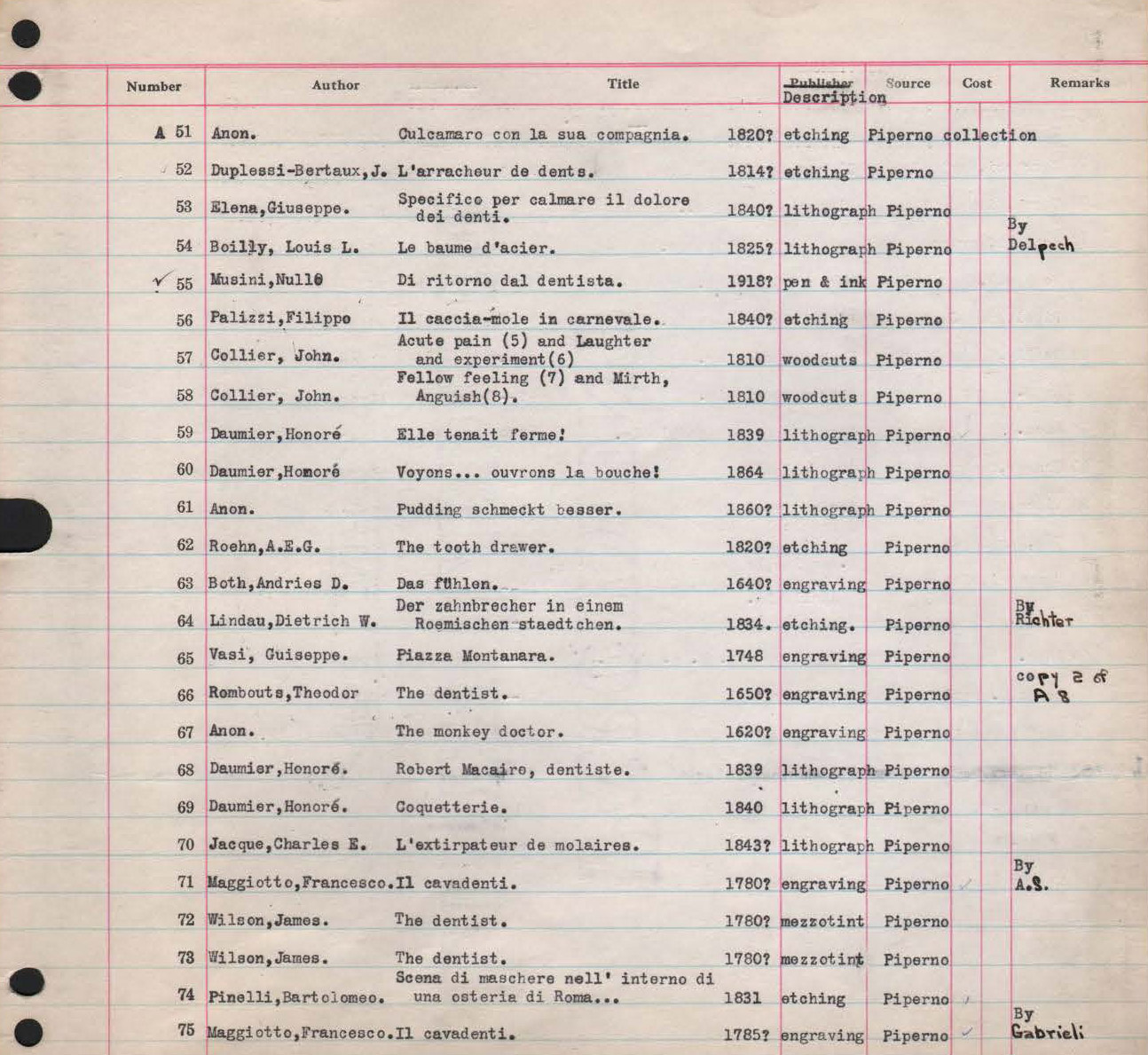 The Dental School Library actively collected illustrations that portrayed dental history and practice and had a large St. Apollonia artwork collection. Once received in 1941, the Piperno collection was absorbed into the existing dental illustrations and St. Apollonia collections in the Dental Library. In the last year, Historical Collections has worked to uncover and reidentify items that were part of the Piperno Collection using accession records and descriptions in the St. Apollonia and Dental Illustrations Digital Collections.
The Dental School Library actively collected illustrations that portrayed dental history and practice and had a large St. Apollonia artwork collection. Once received in 1941, the Piperno collection was absorbed into the existing dental illustrations and St. Apollonia collections in the Dental Library. In the last year, Historical Collections has worked to uncover and reidentify items that were part of the Piperno Collection using accession records and descriptions in the St. Apollonia and Dental Illustrations Digital Collections.
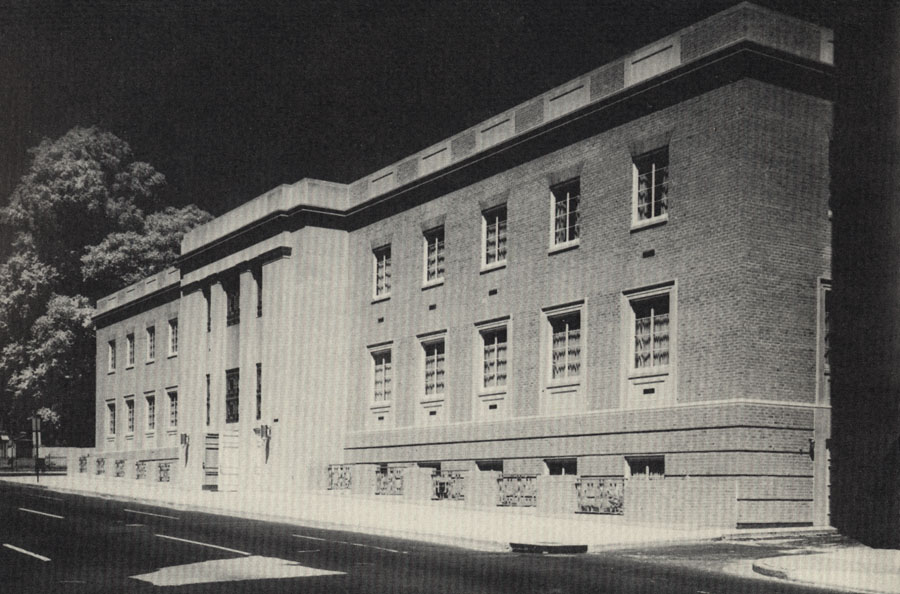 The individual school libraries, including the Dental School Library, were combined when the Health Sciences Library (HSL, precursor to the Health Sciences and Human Services Library) building opened on July 28, 1960, at 111 South Greene Street. The new library building included a designated Historical Collection Department.
The individual school libraries, including the Dental School Library, were combined when the Health Sciences Library (HSL, precursor to the Health Sciences and Human Services Library) building opened on July 28, 1960, at 111 South Greene Street. The new library building included a designated Historical Collection Department.
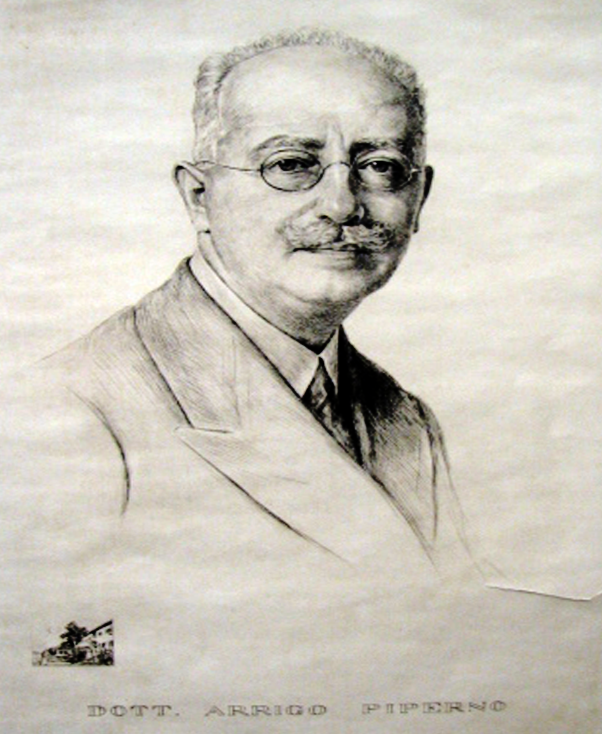 Arrigo Piperno, M.D., D.D.S. was born in 1879 in Spoleto, Italy. He earned a medical degree in Italy before attending the Chicago College of Dental Surgery, earning his D.D.S. in 1908. Following graduation Dr. Piperno returned to Rome, Italy to set up a dental practice. His early research and publications focused on the history of dentistry and medicine. His 1913 text “Bartolomeo Eustachio e il libello ‘, dentibus’,” in La Stomatologia uncovered that Urbain Hemard’s Recherche de la vraye anathomie des dents, nature et proprietez d’icelles (1582), the first French volume on dentistry, was plagarized from Eustachi’s Libellus de Dentibus (1563), the first book on the structure and function of teeth.
Arrigo Piperno, M.D., D.D.S. was born in 1879 in Spoleto, Italy. He earned a medical degree in Italy before attending the Chicago College of Dental Surgery, earning his D.D.S. in 1908. Following graduation Dr. Piperno returned to Rome, Italy to set up a dental practice. His early research and publications focused on the history of dentistry and medicine. His 1913 text “Bartolomeo Eustachio e il libello ‘, dentibus’,” in La Stomatologia uncovered that Urbain Hemard’s Recherche de la vraye anathomie des dents, nature et proprietez d’icelles (1582), the first French volume on dentistry, was plagarized from Eustachi’s Libellus de Dentibus (1563), the first book on the structure and function of teeth.
In 1915, Dr. Piperno became medical captain and head of the Odonto-Stomatological Department of the Italian Red Cross (Croce Rossa Italiana) Hospital of War No. 4. He served in this capacity during the entirety of World War I. While serving and as the war continued on, he published a 1917 article in The Dental Review about his experiences in the war titled “A Dentist’s Help at the Italian Front.” The article described his treatment of soldiers with dental injuries in the Italian warfront hospital and argued that dental treatment was important to keep the men in battle. He states, “My motto is: quick and well — in order to avoid vacancies to the troop.” The article includes a table outlining the operations performed by Dr. Piperno and his associate from July to October 1916; together they had performed 4291 operations.
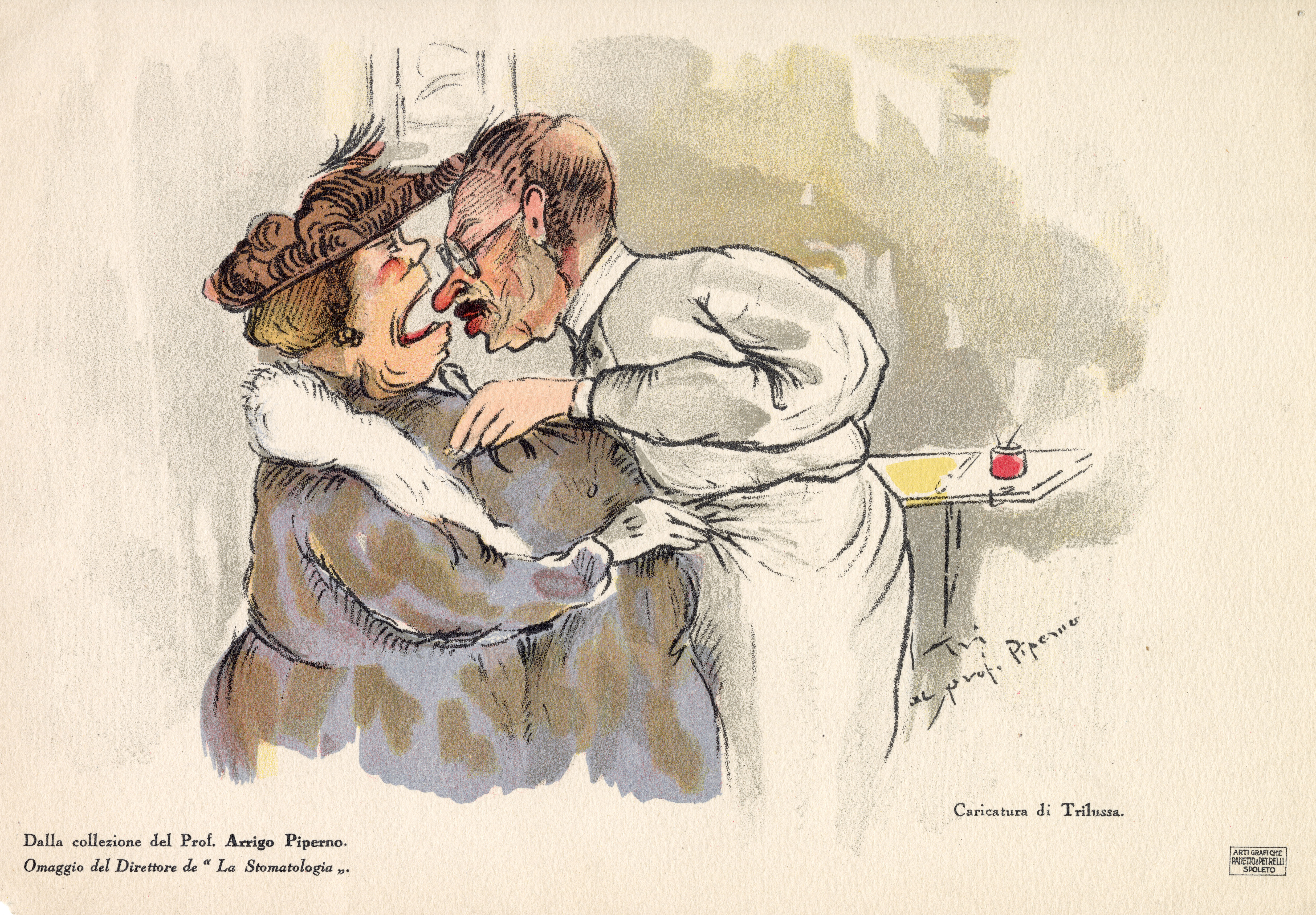 Following the War, Dr. Piperno continued his dental practice in Rome, serving as dentist to influential Italian men. He was the dentist to Pope Pius XII, who granted Piperno and his family, who were Jewish, refuge at the Vatican when Germany occupied Rome during World War II. Dr. Piperno was also dentist to the artist and poet Carlo Alberto Salustri (pseudonym Trilussa), who gave his dentist a series of 19 dental caricatures from 1921 to 1936. Trilussa was mostly known for his poetry but his artwork satirized everyday events and humanity. Four reproductions of Trilussa’s work are part of the HSHSL’s Piperno Collection; the originals are in the Medical Historical Library, Cushing/Whitney Medical Library at Yale University. Also among his famous Italian patients was Benito Mussolini, who he treated from 1925 until Mussolini dismissed him in 1938. In 1933, Dr. Piperno returned to the United States for the Chicago Centennial Dental Congress; while attending Piperno claimed that Mussolini never flinched or reacted to pain while undergoing treatment. Newspapers across the U.S. reported on Piperno’s and Mussolini’s relationship. After being dismissed in 1938, Mussolini continued to protect the Piperno family.
Following the War, Dr. Piperno continued his dental practice in Rome, serving as dentist to influential Italian men. He was the dentist to Pope Pius XII, who granted Piperno and his family, who were Jewish, refuge at the Vatican when Germany occupied Rome during World War II. Dr. Piperno was also dentist to the artist and poet Carlo Alberto Salustri (pseudonym Trilussa), who gave his dentist a series of 19 dental caricatures from 1921 to 1936. Trilussa was mostly known for his poetry but his artwork satirized everyday events and humanity. Four reproductions of Trilussa’s work are part of the HSHSL’s Piperno Collection; the originals are in the Medical Historical Library, Cushing/Whitney Medical Library at Yale University. Also among his famous Italian patients was Benito Mussolini, who he treated from 1925 until Mussolini dismissed him in 1938. In 1933, Dr. Piperno returned to the United States for the Chicago Centennial Dental Congress; while attending Piperno claimed that Mussolini never flinched or reacted to pain while undergoing treatment. Newspapers across the U.S. reported on Piperno’s and Mussolini’s relationship. After being dismissed in 1938, Mussolini continued to protect the Piperno family.
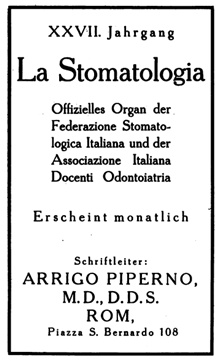 As the famous patients show, Dr. Piperno was the leading dentist in Italy and was active in improving standards for dental education. At the time, to be a dentist in Italy, one had to attend medical school, but few Italian medical schools included dental education in their curriculum. Dr. Piperno argued for the necessity of dental departments within medical schools. He served as lecturer at the Royal University of Medicine in Rome until 1946 and the Director of the Municipal School Dental Clinic in Rome, where he created a program of dental prophylaxis for school children. He was also editor of La Stomatologia, a professional dental journal in Italy. He also invented a dentifrice named the Monteluco and a concentrated solution for the gums called Gengiviticon.
As the famous patients show, Dr. Piperno was the leading dentist in Italy and was active in improving standards for dental education. At the time, to be a dentist in Italy, one had to attend medical school, but few Italian medical schools included dental education in their curriculum. Dr. Piperno argued for the necessity of dental departments within medical schools. He served as lecturer at the Royal University of Medicine in Rome until 1946 and the Director of the Municipal School Dental Clinic in Rome, where he created a program of dental prophylaxis for school children. He was also editor of La Stomatologia, a professional dental journal in Italy. He also invented a dentifrice named the Monteluco and a concentrated solution for the gums called Gengiviticon.
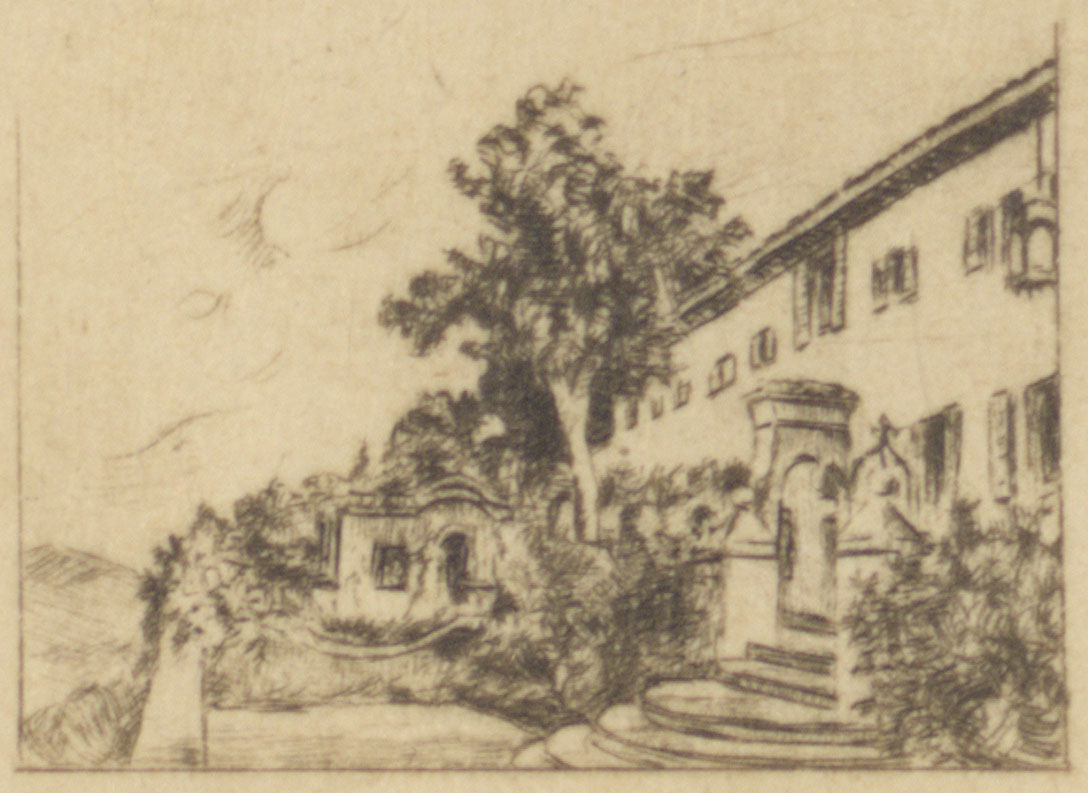 Dr. Piperno was an avid collector of rare books and artwork. In 1918, Dr. Piperno purchased Eremo Delle Grazie in Spoleto, Italy as a refuge for his family. The home was a former monastery with founding dates in the 5th Century AD. When the doctor died in 1947, the home passed to his nephew, Pio Lalli, who continued the conservation work begun by his uncle. In 1991, the home was designated a “Historical Residence” and today is an event space and bed and breakfast.
Dr. Piperno was an avid collector of rare books and artwork. In 1918, Dr. Piperno purchased Eremo Delle Grazie in Spoleto, Italy as a refuge for his family. The home was a former monastery with founding dates in the 5th Century AD. When the doctor died in 1947, the home passed to his nephew, Pio Lalli, who continued the conservation work begun by his uncle. In 1991, the home was designated a “Historical Residence” and today is an event space and bed and breakfast.
While it is unclear why or how the University of Maryland acquired the Piperno Collection in 1941, it remains a valuable part of the HSHSL’s Historical Collections. The collection includes 58 pieces of artwork, satirizing and showcasing dental history and practice, as well as a rare first volume on dentistry in Italian, Odontologia: Ossia, Trattato Sopra I Denti (1786). Some items, including the 1786 volume, from the collection are currently on exhibit outside of the Historical Collection’s reading room on the 5th floor of the HSHSL. For questions about the collection or other items in Historical Collections email, Tara Wink.
References and Additional Readings:
Sarfatti, M.G. (2014). My Fault: Mussolini as I knew Him. Enigma Books. Available at: https://tinyurl.com/29tcv69m
Schullian, D.M. (1954). “Piperno, Trilussa, and Dental Caricature.” Journal of the History of Medicine and Allied Sciences, 9(3), 273-280. Available at: https://www.jstor.org/stable/24618978
“Miscellaneous Notes.” (1941). Journal of the Medical Library Association. 29(4), 215. Available at: https://pmc.ncbi.nlm.nih.gov/articles/PMC233469/

